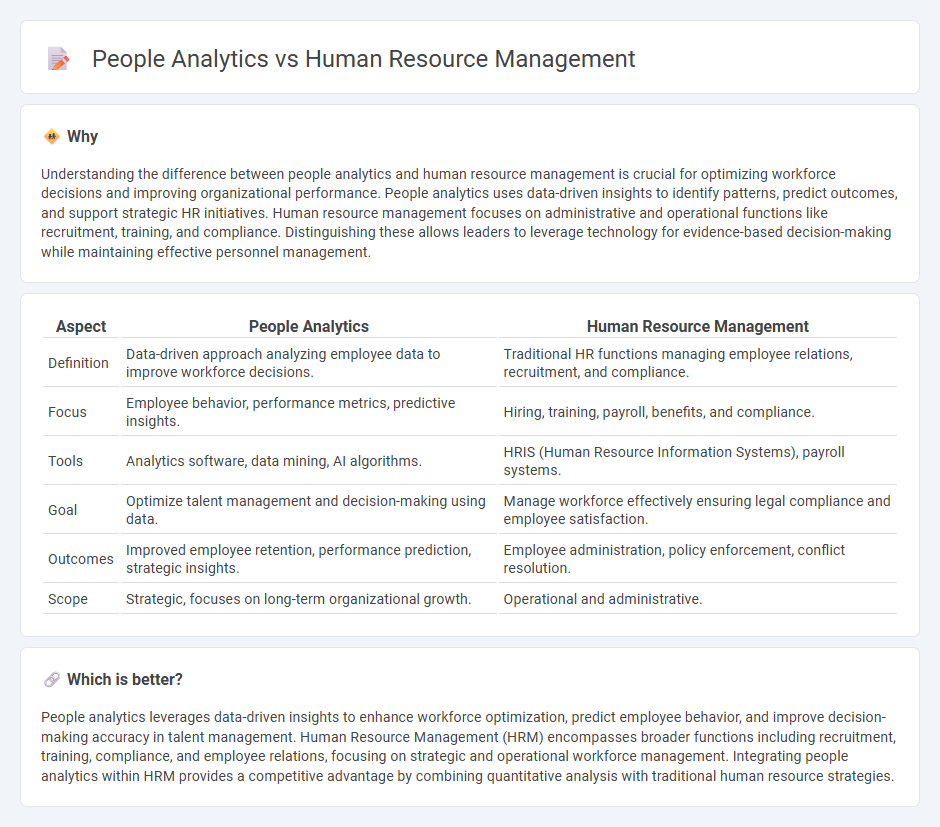
People analytics leverages data-driven insights to optimize workforce performance, employee engagement, and talent acquisition, transforming traditional human resource management practices. Human resource management focuses on recruiting, training, employee relations, and compliance, relying heavily on interpersonal skills and organizational strategy. Explore how integrating people analytics with HR management enhances decision-making and drives business success.
Why it is important
Understanding the difference between people analytics and human resource management is crucial for optimizing workforce decisions and improving organizational performance. People analytics uses data-driven insights to identify patterns, predict outcomes, and support strategic HR initiatives. Human resource management focuses on administrative and operational functions like recruitment, training, and compliance. Distinguishing these allows leaders to leverage technology for evidence-based decision-making while maintaining effective personnel management.
Comparison Table
| Aspect | People Analytics | Human Resource Management |
|---|---|---|
| Definition | Data-driven approach analyzing employee data to improve workforce decisions. | Traditional HR functions managing employee relations, recruitment, and compliance. |
| Focus | Employee behavior, performance metrics, predictive insights. | Hiring, training, payroll, benefits, and compliance. |
| Tools | Analytics software, data mining, AI algorithms. | HRIS (Human Resource Information Systems), payroll systems. |
| Goal | Optimize talent management and decision-making using data. | Manage workforce effectively ensuring legal compliance and employee satisfaction. |
| Outcomes | Improved employee retention, performance prediction, strategic insights. | Employee administration, policy enforcement, conflict resolution. |
| Scope | Strategic, focuses on long-term organizational growth. | Operational and administrative. |
Which is better?
People analytics leverages data-driven insights to enhance workforce optimization, predict employee behavior, and improve decision-making accuracy in talent management. Human Resource Management (HRM) encompasses broader functions including recruitment, training, compliance, and employee relations, focusing on strategic and operational workforce management. Integrating people analytics within HRM provides a competitive advantage by combining quantitative analysis with traditional human resource strategies.
Connection
People analytics leverages data-driven insights to optimize talent acquisition, employee engagement, and performance management within Human Resource Management (HRM). Integrating people analytics enables HR departments to make informed decisions on workforce planning, diversity initiatives, and leadership development. This connection enhances overall organizational effectiveness by aligning human capital strategies with business objectives.
Key Terms
**Human Resource Management:**
Human Resource Management (HRM) involves strategic oversight of workforce planning, recruitment, employee development, and organizational culture to maximize employee performance and satisfaction. It integrates workforce policies, talent acquisition, performance appraisals, and compliance management to align human capital with business goals. Explore the evolving landscape of HRM strategies and tools to enhance organizational success.
Recruitment
Human resource management (HRM) in recruitment emphasizes traditional processes such as job posting, candidate screening, and interviews to identify suitable hires efficiently. People analytics leverages data-driven insights and predictive models to optimize candidate selection, improve diversity, and reduce time-to-hire by analyzing patterns from historical recruitment data. Explore how integrating people analytics into HRM transforms recruitment strategies and outcomes.
Training and Development
Human resource management (HRM) emphasizes structured training and development programs to enhance employee skills and organizational performance. People analytics leverages data-driven insights to identify skill gaps, predict learning outcomes, and tailor personalized development plans for maximizing employee potential. Discover how integrating HRM practices with people analytics can revolutionize workforce training strategies.
Source and External Links
Human resource management - Wikipedia - HRM is a strategic and coherent approach to effectively managing people in organizations, encompassing staffing, training and development, and employee maintenance to boost productivity and loyalty.
What is Human Resource Management (HRM)? - TechTarget - HRM involves recruiting, hiring, deploying, and managing employees as assets to maximize organizational effectiveness and aligns workforce management with company goals and culture.
What Is Human Resource Management? Careers, Skills ... - Coursera - HRM focuses on investing in employee development, fostering workplace culture and satisfaction, and ensuring legal compliance to motivate employees and help organizations achieve their goals.
 dowidth.com
dowidth.com